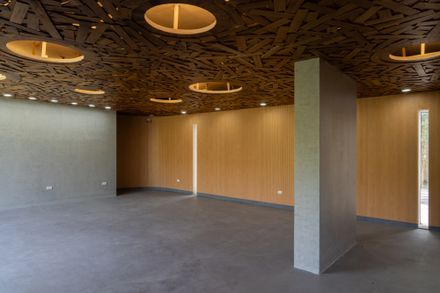Hushan Reservoir Environmental Education Center
ARCHITECTS
Kds Architects
CONTRACTOR
Gaoyuan Construction Co., Ltd.
PRINCIPAL ARCHITECT
Kao, Diing-shyang
DESIGNER, SUPERVISOR
Xie, Yao-zhu
DESIGNER
Hsu, Chia-an
SUPERVISOR
Zhang, Yu-lei
STRUCTURE ENGINEER
Top Technic Engineering Consultant Co. Ltd
MEP & HVAC CONSULTANTS
Guansheng Mechanical And Electrical Technician Office, Yucheng Air Conditioning Technology Co., Ltd.
PHOTOGRAPHS
Manka Huang
AREA
602 M²
YEAR
2024
LOCATION
Taiwan
CATEGORY
Educational Architecture
Text description provided by architect.
The Hushan Reservoir Environmental Education Center, located in Douliu City, Yunlin County, Taiwan, was established as part of conservation and local compensation efforts during the reservoir's construction.
Originally proposed as an environmental and ecological education hall, the center was later added to accommodate local residents' expectations.
Together with the reservoir, ecological conservation area, and nearby settlements, it forms a comprehensive environmental education park promoting natural ecology, cultural heritage, and community life development.
A key cultural element is the Stone God, a significant local landmark relocated due to the reservoir's construction.
Traditionally, residents circled it three times for protection while herding cattle. Along with the Wanshan God and the Earth God, it was moved to an open space in front of the dam, forming the Three Gods Park.
The education center, positioned between the park and the dam, symbolizes both conservation and community sentiment.
The center's design draws from the natural elements of stone, water, and earth, integrating historical, environmental, and emotional themes:
1. ARCHITECTURAL EXPRESSION OF HISTORY
The auditorium's placement and form symbolize the revealing of the Stone God, reflecting historical changes.
2. EMOTIONAL CONNECTION
Its trapezoidal shape echoes the dam, linking the reservoir, the Stone God, and nearby settlements.
3. ENVIRONMENTAL HARMONY
A column-free interior allows free spatial flow, resonating with the reservoir and nearby stream.
4. MEMORY EVOCATION
The circulation route mimics the ritual circling of the Stone God, reinforcing historical memory.
5. LANDSCAPE INTEGRATION
Large windows frame views of the dam, Stone God, and conservation area, strengthening site connection.
6. SUSTAINABILITY
Shaded windows, natural ventilation, and foldable doors minimize energy consumption while maintaining comfort.
7. LAND TRANSFORMATION EXPLORATION
Rooftop greenery and wind turbines highlight the balance between development and conservation.
8. SYMBOLIC JOURNEY
South-facing stairs recall herders' mountain ascents, adding cultural depth.
9. WATER AS A THEME
The rooftop's water droplet shape and basin symbolize the reservoir's role in sustaining life.
10. LOCAL MATERIALS AND TEXTURES
Regional stone, reclaimed wood, and metal elements blend the building into its surroundings.
11. LOW-TECH, LOW-COST APPROACH
Emphasizing handmade, maintainable construction, the center merges with the landscape seamlessly.
The Hushan Reservoir Environmental Education Center is not just an architectural entity but a reconciliation between human development and environmental preservation. It serves as a hub for ecological education and cultural heritage, fostering awareness of the delicate balance between nature and community.





































